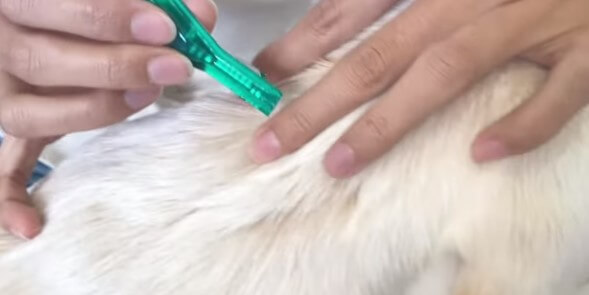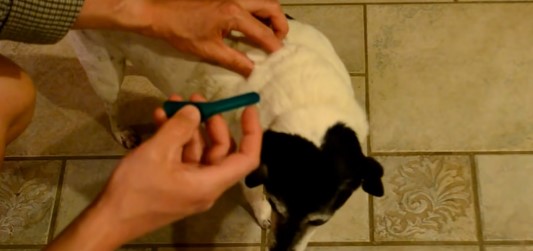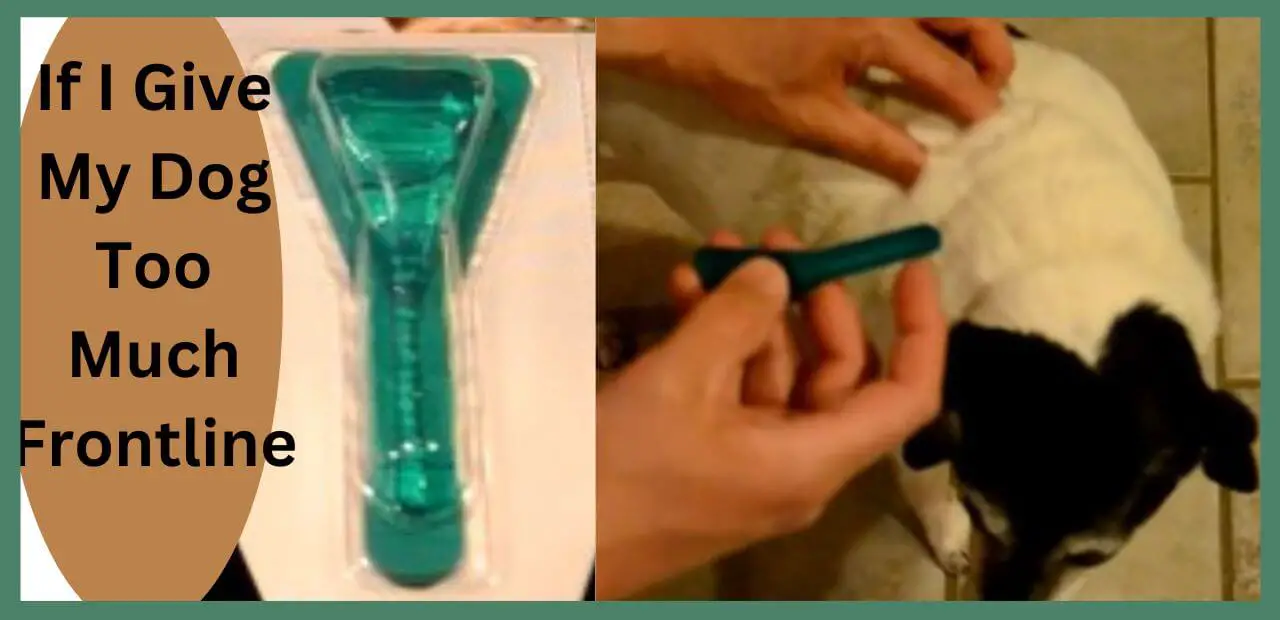Frontline is a popular flea and tick treatment medication for dogs and cats. It works by disrupting the nervous system of pests to kill them. However, some pet owners may be wondering – what happens if I give my dog too much Frontline?
Giving too large a dose of this pesticide can cause toxic side effects in pets.
This article will explore what overdosing on Frontline does, signs of Frontline toxicity, how much is too much, and how to treat dogs who ingest too much of this medication.
What Exactly is Frontline and How Does it Work?
Frontline is a brand name for a flea and tick control product containing the active ingredients Fipronil and S-Methoprene. It works by distributing the pesticide throughout your dog’s oils glands in the skin.
When fleas and ticks come into contact with your dog, they ingest the poison through their exoskeleton and it disrupts their nervous system leading to death. Frontline is applied topically, usually once a month during flea season.
It kills existing pests within 24-48 hours and continues working to prevent reinfestation for up to a month. Only a small amount is needed based on your dog’s weight to provide effective protection.
What Happens if My Dog is Given Too Much Frontline?
Giving your dog too large a dose of Frontline can poison them, leading to adverse reactions. Frontline contains Fipronil, the same ingredient found in pesticide roach baits. Ingesting too much Frontline can overload your dog’s system.
The nervous system effects that kill fleas and ticks can end up harming your pet. Side effects of Frontline toxicity include agitation, seizures, vomiting, weak or uncoordinated movement, and irritability. In severe cases it may cause neurological issues or even death.
The effects often depend on the size of the dog and how much excess Frontline was applied. Small dogs are at greater risk.
What are the Symptoms of Frontline Poisoning in Dogs?
There are several symptoms to look out for if you suspect your dog has ingested too much Frontline:
- Tremors, shaking, twitching, seizures
- Agitation, restlessness, irritability
- Weakness, lack of coordination when moving
- Vomiting, diarrhea
- Dilated pupils
- Panting, high body temperature
- Collapse, loss of consciousness
Dogs may also engage in uncharacteristic behavior like whining, hiding, digging, chewing, barking, or self-mutilation. Symptoms typically onset within 4-12 hours after topical overapplication.
However, it can sometimes take 24 hours for poisoning signs to manifest. The longer it takes for symptoms to appear, the higher the dose is likely to be. Immediate vet attention is required to treat Frontline toxicity.
How Much Frontline is Dangerous for Dogs?
The amount of Frontline that can potentially poison a dog depends on its size. Frontline is dosed by a dog’s weight, normally ranging from 45-88 pounds per dog. Dogs under 20 pounds only need a few drops.
Squeeze entire tubes meant for much larger dogs can overload a small dog’s system. For example, a tube for an 85 pound dog contains 9 times the dose for a 10 pound dog. Misapplying this much to a small dog could be toxic.
Cats are also at high risk since their smaller size requires much less Frontline. For mild poisoning, just 2-3 times the proper dose may cause symptoms. Moderate to severe poisoning usually requires 5 times an appropriate dose or more.
However, every dog is different and may react differently based on sensitivity. It’s impossible to give an exact overdose amount that applies to all dogs. Any amount well above what your dog should get warrants caution.
What Should I Do if My Dog is Overdosed on Frontline?
If you realize or suspect you have overdosed your dog on Frontline, act immediately. Overapplication is considered a veterinary emergency. Try wiping off any excess product still on their fur gently with a cloth and wash the area if possible.
Ensure your dog does not lick and ingest more. Inducing vomiting may help eliminate some Frontline if done soon after topical overdose, but only under vet guidance.
Rushed decontamination can save lives. Get your dog to a vet clinic as quickly as possible even if they do not yet show symptoms, as these can take up to 24 hours to present.
Vets can induce vomiting or administer activated charcoal to absorb poison if warranted. They can also give intravenous fluids and injectable anti-seizure medications as needed for symptomatic treatment. Blood or urine tests help confirm Frontline toxicity.
Sedation and anticonvulsant medications may be prescribed once your dog is stabilized. With prompt aggressive treatment dogs have a good chance of recovering fully from Frontline overdose.
However, the prognosis worsens the longer toxins circulate before treatment starts.
How Does Frontline Toxicity Treatment and Prognosis Vary by the Amount Ingested?
The treatment approach and prognosis for Frontline toxicity depends greatly on how much excess was applied to the dog.
Mild overdose – 1 to 2 times proper dose: Inducing vomiting and giving activated charcoal may be all that’s needed. Most dogs recover fully with just decontamination and have an excellent prognosis.
Moderate overdose – 3 to 5 times recommended amount: More aggressive treatment is warranted. Dogs may require anticonvulsant drugs, IV fluids, sedation, and hospitalization for several days.
The prognosis is still fairly good with prompt treatment. However, some lingering nervous system issues are possible.
Severe overdose – over 5 times proper dose: This requires very aggressive decontamination, treatment, and support.
The higher the overdose, the poorer the prognosis and higher risk of life-threatening complications like seizures, coma, respiratory failure, or organ damage.
Prolonged vet ICU hospitalization is likely needed. If the dog survives the initial toxicity crisis, they may still suffer long-term health issues.
Amount of time between overdose and treatment also impacts prognosis. The longer Frontline circulates before treatment starts, the more damage can occur. If over 24 hours lapse before the overdose is discovered, the prognosis dramatically declines.
However, starting decontamination even 12 hours post-exposure can still save lives vs. waiting 24 hours or more. Quick discovery and action is key to recovery. Still, the overall dose the dog received plays a central role.
Mild overdoses have an excellent outlook while severe overdoses may have a poor prognosis even with the best care. Working with your vet to quantify the likely amount ingested helps guide expectations.
Can Frontline Be Fatal and What Causes Death from Overdose?

Yes, in severe cases, Frontline overdose can be fatal to dogs. Death is most likely to occur from neurological complications like uncontrollable seizures or from secondary issues like liver and kidney failure.
The direct effects of Frontline on the nervous system can suppress respiratory drive leading to hypoxia. It can also disrupt thermoregulation causing life-threatening overheating.
The mechanism of death depends on the dose and resulting symptoms, but usually relates to one of the following:
- Extreme seizure activity, causing cardiac arrest or brain damage
- Respiratory depression and hypoxemia
- Hyperthermia and heat stroke
- Hemorrhagic gastroenteritis, fluid/electrolyte imbalance, and shock
- Liver or kidney failure
In less severe cases, muscle tremors and twitching can lead to extreme fatigue, metabolic disturbances, and multi-organ dysfunction. Any of these effects can ultimately be fatal if unchecked.
Even with aggressive therapy, very high overdoses may overwhelm the body’s ability to cope with the toxins. The higher the overdose, the poorer the odds of survival.
However, early action to decontaminate and support vital functions can prevent a fatal outcome in many cases. Working closely with your veterinarian is key if overdosing is suspected.
Are Some Dogs More Prone to Toxicity from Too Much Frontline?
Yes, some dogs are at higher risk for Frontline toxicity if overdosed. Dogs most vulnerable include:
- Smaller dogs under 20 pounds. Less Frontline is needed, so excess is more toxic.
- Young puppies under 16 weeks old. More sensitive nervous systems.
- Elderly dogs. May have compromised organ function to process toxins.
- Dogs with existing epilepsy or seizure disorders. More prone to neurological reactions.
- Breeds like herding dogs and collies with MDR1 gene mutation. May not excrete Frontline efficiently.
- Dogs with thyroid issues or Cushing’s disease. Altered metabolism of medications.
- Sick, weak, or debilitated dogs. Harder to break down and excrete excess Frontline.
- Dogs previously or concurrently exposed to other pesticides. Increased toxicity.
While any dog is at risk if given too much Frontline, these higher risk groups have less of a margin of safety.
What may be a mild to moderate overdose in many dogs could cause severe, even life-threatening toxicity in these particular dogs.
Using extreme caution with dosage guidelines and monitoring after application is especially important.
If you have a sensitive dog prone to medication reactions, consider discussing alternatives to Frontline with your veterinarian beforehand.
How Can I Prevent Overdosing My Dog on the Frontline in the Future?

To avoid potentially overdosing your dog with Frontline, follow these tips:
- Carefully follow all dosing instructions based on your dog’s current weight. Do not estimate or guess.
- Consult your vet if you are unsure about the proper dose. Overdosing by accident is far too common.
- Apply only the number of tubes specified for your dog’s weight – do not round up or use multiple tubes unless explicitly directed by your vet.
- Avoid applying again before the month is up – Frontline lasts 30 days. Reset reminders to track when it’s time to reapply.
- Prevent your dog from excessively licking the Frontline immediately after application.
- Supervise young children around your dog after Frontline is applied to prevent ingestion.
- Properly store Frontline out of reach of pets to avoid accidental ingestion.
- Monitor your dog closely for the first 48 hours after each new application for any signs of reaction or sensitivity.
- If you have a high-risk dog, ask your vet about alternative flea prevention products that may be safer.
- Carefully separate dogs before application to avoid applying too much to the wrong dog.
With some simple precautions, you can ensure your dog gets the flea protection they need without accidentally going overboard on the dosage.
What Should I Do if I Suspect My Dog Has Ingested Too Much Frontline?
If you suspect an overdose of Frontline on your dog, remain calm but act quickly. Look for any signs of a reaction like agitation, muscle tremors, vomiting, or uncoordinated movements.
Safely remove them from the area where excess Frontline may still be present. Try gently wiping off any product still on their fur, but avoid letting them lick it off during grooming.
Never induce vomiting at home as inhaling Frontline can cause aspiration pneumonia. Time is critical, so call your vet or an emergency animal hospital immediately to alert them you’re on the way.
They may advise you to come in right away even if symptoms are not yet present, as these can take up to 24 hours to appear. Bring the Frontline packaging with you showing the concentration and amount applied.
Get your dog medical attention as soon as possible where vomiting can be safely induced or charcoal may be given to absorb toxin internally.
With rapid appropriate treatment, most dogs recover fully. Never wait to see if symptoms materialize before taking action.
The quicker the overdose is addressed, the better the likely outcome will be for your dog’s health and safety. Don’t take chances with possible Frontline toxicity
Frequently Ask Question Of What Happens If I Give My Dog Too Much Frontline

What are the symptoms of too much Frontline?
Excessive drooling, vomiting, diarrhea, lethargy, and lack of coordination can signal too much Frontline was applied. Tremors, seizures, restlessness, and abnormal vocalization may also indicate Frontline toxicity in dogs. Immediate veterinary treatment is crucial if an overdose is suspected.
Can you put too much Frontline on your dog?
Yes, applying more Frontline than the recommended dose for your dog’s weight can certainly lead to poisoning. Overdosing on this flea medication can cause neurological issues, seizures, vomiting, and even death in severe cases. Extreme caution is needed with Frontline dosage.
What happens if I give my dog two doses of Frontline?
Administering two full doses of Frontline close together overexposes your dog to the pesticide fipronil and can poison them. Double dosing requires immediate veterinary treatment to induce vomiting and provide supportive care. Symptoms like seizures, agitation, and lethargy may result.
Conclusion
As we’ve explored, giving your dog an excessive dose of the flea medication Frontline can be extremely dangerous and even life-threatening. The pesticide fipronil found in Frontline works by attacking the nervous system of insects.
When dogs get too much, it has the same neurotoxic effect. Small dogs, puppies, elderly pets, and dogs with existing health conditions tend to be most at risk for severe reactions.
Overdose symptoms like seizures, vomiting, and agitation require emergency veterinary treatment to try and prevent lasting harm or death.
Prompt, aggressive efforts to decontaminate the dog’s system and provide supportive care are crucial. The higher the inadvertent overdose, the more intensive the treatments needed and the poorer the prognosis typically is.
While accidental Frontline toxicity does occur, careful adherence to dosing guidelines based on your individual dog’s weight is key to keeping your pet safe. Always monitor for any subtle reactions after each application as well.
If an overdose is suspected, immediate action can go a long way toward saving your dog’s life.
- Smelly House Because of Dog? Take These Hygiene Tips - May 20, 2025
- How to Introduce a Dog To a Cats Without Chaos - May 6, 2025
- 4 Best Cavapoo Rescues in the UK 2024 - April 5, 2024









